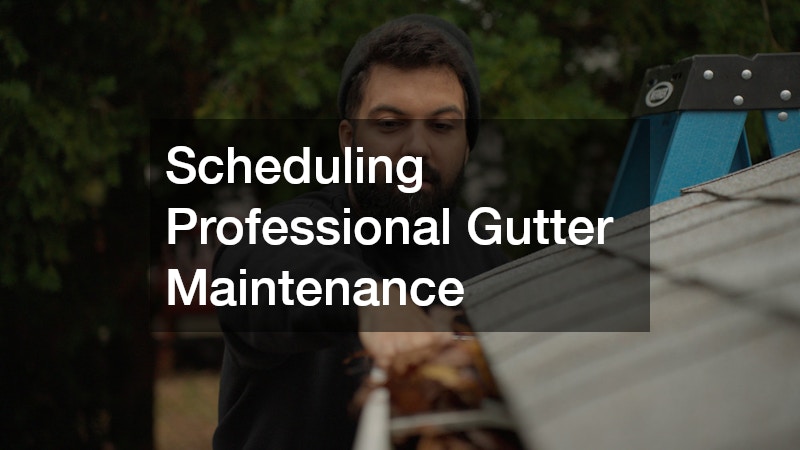Gutter systems serve an essential role in maintaining the structural integrity of a home, especially during severe weather conditions. Neglecting gutter repair and maintenance after storms and heavy rain can lead to costly repairs and potential damage to your property. It’s crucial to address common issues promptly to prevent more significant problems, like water damage and erosion, from developing.
How Heavy Rains and Storms Affect Gutters
Clogged Gutters from Debris
Heavy rains and storms often bring leaves, twigs, and other debris that can quickly accumulate in gutters, obstructing water flow. When gutters become clogged, they can overflow, causing water to seep into the roof or sides of the house, leading to damage over time. Regular cleaning after storms is key to preventing clogs and ensuring water drains efficiently away from the home.
During severe weather, debris like shingle granules and mud can also find their way into gutters, adding to the blockage. This accumulation can cause the gutters to become heavy and sag, compromising their structure and effectiveness. Homeowners should be vigilant about clearing gutters of debris to maintain their functionality.
Damage to Gutter Structures
Strong winds and the pressure from heavy rains can lead to physical damage to gutter systems. Dents and bends are common after storms, especially if gutters are struck by falling branches or debris. This physical damage can impair the gutter’s ability to channel water away effectively, leading to overflow and water damage.
Gutter systems are also susceptible to detachment or complete collapse under the weight of accumulated debris and water. Such incidents are more frequent with poorly maintained or aged gutters, unable to withstand the pressure exerted by stormy weather. Regular inspections and reinforcement of the gutter structure are beneficial to prevent such deterioration.
Signs of Gutter Damage to Look Out For
Visible Gutter Sagging or Leaks
After a storm, visible signs such as sagging gutters can indicate that repair is necessary. Sagging sections are often a result of excessive weight from debris and standing water, showing that the gutters are not functioning correctly. Spotting these issues early can help homeowners address problems before they escalate into significant repairs.
Leaks are another red flag that suggests the gutter system might be compromised. Leaks can occur at the seams or joints or through holes caused by rust or physical damage. Identifying and repairing leaks quickly can prevent further water damage to the home.
Water Damage Around the Home
Water stains on the exterior walls of your home can be telltale signs of gutter issues, often indicating overflow or leaks. These stains can be unsightly and, if left unaddressed, can lead to more extensive damage like mold growth or rotting siding. Inspecting for these marks after heavy rainfall can help ensure that gutter problems are identified and corrected early.
Foundation problems, such as cracks or water pooling around the base of the home, can also be indicative of faulty gutter systems. Properly functioning gutters and downspouts should divert water away from the foundation, so noticing these issues should prompt an immediate gutter inspection. Protecting the foundation is crucial for maintaining the home’s structural stability and value.
How Often Gutters Should Be Inspected and Repaired
Recommended Inspection Frequency
Experts recommend checking gutters at least twice a year, ideally during the fall and spring, to prep for and recover from adverse weather conditions. However, after significant storms or heavy rainfall, it is wise to perform additional checks to catch any issues caused by these events. Regular inspections help identify and address minor problems before they become costly repairs.
Seasonal inspections should include checking for clogs, ensuring the structure is sound, and making sure all parts are securely fastened. Homeowners with homes in heavily wooded areas or with older gutter systems may need more frequent inspections due to higher risks of debris accumulation and wear. Being proactive in gutter maintenance can save homeowners time and money in the long run.
Scheduling Professional Gutter Maintenance
While some homeowners may prefer a DIY approach for minor gutter cleanings and repairs, professional maintenance services offer significant benefits. Experts can provide thorough inspections, identify unseen problems, and implement precise repairs to maintain the gutter system’s efficiency. Hiring professionals ensures that no critical details are overlooked during maintenance checks.
During a professional inspection, technicians will assess the gutters’ alignment, check for secure attachments, and remove any significant debris blockages. They will also inspect all components of the system, including downspouts and fascia, to ensure that water is effectively diverted away from the property. Knowing what to expect during these sessions helps homeowners make informed decisions about their gutter care.
The importance of regular gutter maintenance cannot be overstated when it comes to safeguarding your home from water damage following heavy storms and rain. Timely repairs and inspections ensure that gutters function properly, preventing costly structural damage and maintaining the home’s value. By understanding the impacts of stormy weather on gutters and addressing issues early, homeowners can enjoy peace of mind knowing their homes are well-protected.

